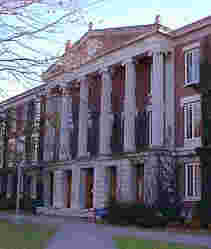![[LIGO logo]](bluelogo_sm.gif)
![[LIGO logo]](bluelogo_sm.gif) |
LIGO Rochester Group |
 |
|||
| Group Members
Faculty: |
|||
| A.C. Melissinos | M. F. Bocko | ||
| phone: (585) 275-2707 | phone: (585) 275-4879 |
||
| fax : (585) 506-0018 | fax: (585) 473-0486 |
||
| meliss@pas.rochester.edu | bocko@ece.rochester.edu | ||
| Post Doc: | |||
| W.E. Butler | |||
| phone: (585) 275-4363 | |||
| fax : (585) 506-0018 | |||
| butler@pas.rochester.edu | |||
| Undergrad: |
|||
| N. Stull |
|||
| phone: (585) 275-4363 |
|||
| fax: (585) 506-0018 |
|||
| nstull@mail.rochester.edu |
|||
| LIGO Observation sites | LIGO Primary sites | ||
| LIGO Hanford | LIGO Louisiana | LIGO Home | LSC Home |
| UR Documents/Notes | Internal Directories |
Rochester is a member of the LIGO Science Collaboration (LSC).The LIGO Scientific Collaboration (LSC) is a forum for organizing technical and scientific research in LIGO. Its mission is to insure equal scientific opportunity for individual participants and institutions by organizing research, publications, and all other scientific activities. It includes scientists from the LIGO Laboratory as well as collaborating institutions. It is a separate organization from the LIGO Laboratory, with its own leadership and governance, but reports to the Laboratory Directorate for final approval of its research program, technical projects, observational physics publications, and talks announcing new observations and physics results.
Construction of buildings and vacuum systems has been completed at the two LIGO observatory facilities in Hanford, WA and Livingston, LA. Each facility will house laser interferometers, consisting of mirrors suspended at each of the corners of a gigantic L-shaped vacuum system, measuring 4 kilometers (2-1/2 miles) on a side. Precision laser beams in the interferometers will sense small motions of the mirrors that are caused by a gravitational wave. Commissioning of these interferometers is now under way. Some preliminary science data has been gathered (in what is refered to as a science run) and is currently being studied for use in generating upper limits on feasable detection of GW events. Commissioning continues in between these science runs to improve the reliability and sensitivity of the instruments.
Gravitational waves that originated hundreds of millions of lights years from earth are expected to distort the 4-kilometers mirror spacing by about a thousandth of a fermi, less than one tenth of a trillionth of the diameter of a human hair. These waves were first predicted by Einstein's Theory of General Relativity in 1916, but the technology to make their detection did not exist then. Now at the turn of this new century, we believe the technology to make detection is at hand.